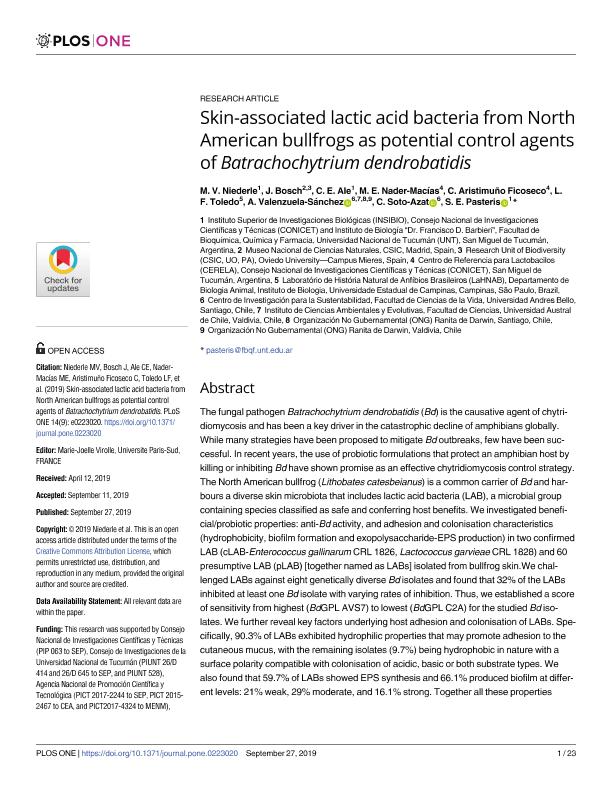Mostrar el registro sencillo del ítem
dc.contributor.author
Niederle, María Virginia

dc.contributor.author
Bosch, Jaime
dc.contributor.author
Ale, Cesar Emmanuel

dc.contributor.author
Nader, Maria Elena Fatima

dc.contributor.author
Aristimuño Ficoseco, Maria Cecilia

dc.contributor.author
Toledo, Luis Felipe
dc.contributor.author
Valenzuela-Sánchez, Andrés
dc.contributor.author
Soto-azat, Claudio
dc.contributor.author
Pasteris, Sergio Enrique

dc.date.available
2021-01-05T21:10:07Z
dc.date.issued
2019-09
dc.identifier.citation
Niederle, María Virginia; Bosch, Jaime; Ale, Cesar Emmanuel; Nader, Maria Elena Fatima; Aristimuño Ficoseco, Maria Cecilia; et al.; Skin-associated lactic acid bacteria from North American bullfrogs as potential control agents of Batrachochytrium dendrobatidis; Public Library of Science; Plos One; 14; 9; 9-2019; 1-23; e0223020
dc.identifier.issn
1932-6203
dc.identifier.uri
http://hdl.handle.net/11336/121566
dc.description.abstract
The fungal pathogen Batrachochytrium dendrobatidis (Bd) is the causative agent of chytridiomycosis and has been a key driver in the catastrophic decline of amphibians globally. While many strategies have been proposed to mitigate Bd outbreaks, few have been successful. In recent years, the use of probiotic formulations that protect an amphibian host by killing or inhibiting Bd have shown promise as an effective chytridiomycosis control strategy. The North American bullfrog (Lithobates catesbeianus) is a common carrier of Bd and harbours a diverse skin microbiota that includes lactic acid bacteria (LAB), a microbial group containing species classified as safe and conferring host benefits. We investigated beneficial/probiotic properties: anti-Bd activity, and adhesion and colonisation characteristics (hydrophobicity, biofilm formation and exopolysaccharide-EPS production) in two confirmed LAB (cLAB-Enterococcus gallinarum CRL 1826, Lactococcus garvieae CRL 1828) and 60 presumptive LAB (pLAB) [together named as LABs] isolated from bullfrog skin.We challenged LABs against eight genetically diverse Bd isolates and found that 32% of the LABs inhibited at least one Bd isolate with varying rates of inhibition. Thus, we established a score of sensitivity from highest (BdGPL AVS7) to lowest (BdGPL C2A) for the studied Bd isolates. We further reveal key factors underlying host adhesion and colonisation of LABs. Specifically, 90.3% of LABs exhibited hydrophilic properties that may promote adhesion to the cutaneous mucus, with the remaining isolates (9.7%) being hydrophobic in nature with a surface polarity compatible with colonisation of acidic, basic or both substrate types. We also found that 59.7% of LABs showed EPS synthesis and 66.1% produced biofilm at different levels: 21% weak, 29% moderate, and 16.1% strong. Together all these properties enhance colonisation of the host surface (mucus or epithelial cells) and may confer protective benefits against Bd through competitive exclusion. Correspondence analysis indicated that biofilm synthesis was LABs specific with high aggregating bacteria correlating with strong biofilm producers, and EPS producers being correlated to negative biofilm producing LABs. We performed Random Amplified Polymorphic DNA (RAPD)-PCR analysis and demonstrated a higher degree of genetic diversity among rod-shaped pLAB than cocci. Based on the LAB genetic analysis and specific probiotic selection criteria that involve beneficial properties, we sequenced 16 pLAB which were identified as Pediococcus pentosaceus, Enterococcus thailandicus, Lactobacillus pentosus/L. plantarum, L. brevis, and L. curvatus. Compatibility assays performed with cLAB and the 16 species described above indicate that all tested LAB can be included in a mixed probiotic formula. Based on our analyses, we suggest that E. gallinarum CRL 1826, L. garvieae CRL 1828, and P. pentosaceus 15 and 18B represent optimal probiotic candidates for Bd control and mitigation.
dc.format
application/pdf
dc.language.iso
eng
dc.publisher
Public Library of Science

dc.rights
info:eu-repo/semantics/openAccess
dc.rights.uri
https://creativecommons.org/licenses/by/2.5/ar/
dc.subject
AMPHIBIAN DECLINES
dc.subject
CHYTRIODIMYCOSIS
dc.subject
LITHOBATES CATESBEIANUS
dc.subject
LACTIC ACID BACTERIA
dc.subject
PROBIOTICS
dc.subject.classification
Otras Ciencias Biológicas

dc.subject.classification
Ciencias Biológicas

dc.subject.classification
CIENCIAS NATURALES Y EXACTAS

dc.title
Skin-associated lactic acid bacteria from North American bullfrogs as potential control agents of Batrachochytrium dendrobatidis
dc.type
info:eu-repo/semantics/article
dc.type
info:ar-repo/semantics/artículo
dc.type
info:eu-repo/semantics/publishedVersion
dc.date.updated
2020-11-18T16:42:35Z
dc.journal.volume
14
dc.journal.number
9
dc.journal.pagination
1-23; e0223020
dc.journal.pais
Estados Unidos

dc.journal.ciudad
San Francisco
dc.description.fil
Fil: Niederle, María Virginia. Consejo Nacional de Investigaciones Científicas y Técnicas. Centro Científico Tecnológico Conicet - Tucumán. Instituto Superior de Investigaciones Biológicas. Universidad Nacional de Tucumán. Instituto Superior de Investigaciones Biológicas; Argentina
dc.description.fil
Fil: Bosch, Jaime. Consejo Superior de Investigaciones Científicas; España. Universidad de Oviedo; España
dc.description.fil
Fil: Ale, Cesar Emmanuel. Consejo Nacional de Investigaciones Científicas y Técnicas. Centro Científico Tecnológico Conicet - Tucumán. Instituto Superior de Investigaciones Biológicas. Universidad Nacional de Tucumán. Instituto Superior de Investigaciones Biológicas; Argentina
dc.description.fil
Fil: Nader, Maria Elena Fatima. Consejo Nacional de Investigaciones Científicas y Técnicas. Centro Científico Tecnológico Conicet - Tucumán. Centro de Referencia para Lactobacilos; Argentina
dc.description.fil
Fil: Aristimuño Ficoseco, Maria Cecilia. Consejo Nacional de Investigaciones Científicas y Técnicas. Centro Científico Tecnológico Conicet - Tucumán. Centro de Referencia para Lactobacilos; Argentina
dc.description.fil
Fil: Toledo, Luis Felipe. Universidade Estadual de Campinas; Brasil
dc.description.fil
Fil: Valenzuela-Sánchez, Andrés. Universidad Andrés Bello; Chile. Universidad Austral de Chile; Chile
dc.description.fil
Fil: Soto-azat, Claudio. Universidad Andrés Bello; Chile
dc.description.fil
Fil: Pasteris, Sergio Enrique. Consejo Nacional de Investigaciones Científicas y Técnicas. Centro Científico Tecnológico Conicet - Tucumán. Instituto Superior de Investigaciones Biológicas. Universidad Nacional de Tucumán. Instituto Superior de Investigaciones Biológicas; Argentina. Universidad Nacional de Tucumán. Facultad de Bioquímica, Química y Farmacia; Argentina
dc.journal.title
Plos One

dc.relation.alternativeid
info:eu-repo/semantics/altIdentifier/doi/http://dx.doi.org/10.1371/journal.pone.0223020
dc.relation.alternativeid
info:eu-repo/semantics/altIdentifier/url/https://journals.plos.org/plosone/article?id=10.1371/journal.pone.0223020
Archivos asociados
